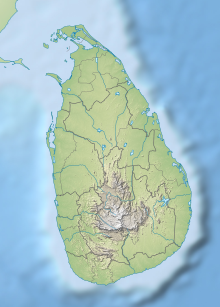Wilpattu National Park
| Wilpattu National Park | |
|---|---|
 A black-winged stilt in Wilpattu National Park | |
| Location | 185km away from Colombo, North Western and North Central provinces, Sri Lanka |
| Nearest city | Anuradhapura |
| Coordinates | 8°26′N 80°00′E / 8.433°N 80.000°E |
| Area | 131667.1 ha |
| Established | December 25, 1938 |
| Governing body | Department of Wildlife Conservation |
Wilpattu National Park (Willu-pattu; Land of Lakes) is a park located on the island of Sri Lanka. The unique feature of this park is the existence of "Willus" (Natural lakes) - Natural, sand-rimmed water basins or depressions that fill with rainwater. Located in the Northwest coast lowland dry zone of Sri Lanka. The park is located 30 km west Anuradhapura and located 26 km north of Puttalam (approximately 180 km north of Colombo). The park is 131, 693 hectares and ranges from 0 to 152 meters above sea level. Nearly sixty lakes (Willu) and tanks are found spread throughout Wilpattu. Wilpattu is the largest and one of the oldest National Parks in Sri Lanka. Wilpattu is among the top national parks world-renowned for its leopard (Panthera pardus kotiya) population. A remote camera survey was conducted in Wilpattu from July to October 2015 by the Wilderness & Wildlife Conservation Trust. A sample of forty nine individual leopards were photo-captured in the surveyed area and the core area density was between that of Yala National Park's Block I and Horton Plains National Park.
History
The Mahavansa records that in 543 BC Prince Vijaya landed at Tambapanni now known as Kudrimalai Point (Horse Point), married Kuweni and founded the Sinhala nation. In 1905 the area was designated a sanctuary and in 1938 it was upgraded to the National Park status.' [1]
Climate
The Annual Rainfall is about 1000mm and the annual temperature is about 27.2 degrees. Inter-monsoonal rains in March and the northeast monsoon (December – February) are the main sources of rainfall.
Flora
There are many types of vegetation to be found in Wilpattu, including littoral vegetation, such as salt grass and low scrub monsoon forest with tall emergents, such as palu (Manilkara hexandra), and satin (Chloroxylon swietenia), milla (Vitex altissima), weera (Drypetes sepiaria), ebony (Diospyros ebenum) and wewarna (Alseodaphne semecapriflolia).
Fauna
31 species of mammals have been identified within Wilpattu national park. Mammals that are identified as threatened species living within the Wilpattu National Park are the elephant (Elephas maximus), sloth bear (Melursus ursinus), leopard (Panthera pardus kotiya) and water buffalo (Bubalus bubalis). Sambhur, spotted deer, mongoose, mouse and shrew are more of Wilpattu's residents.
Birds
The painted stork, the open bill, little cormorant, Sri Lankan junglefowl (Gallus lafayetii) along with many species of owls, terns, gulls, eagles, kites buzzards are to be found at Wilpattu National Park. Wetland bird species that can be seen in Wilpattu are the garganey (Anas querquedula), pintail (Anas acuta), whistling teal (Dendrocygna javanica), spoonbill (Platalea leucorodia), white ibis (Threskiornis malanocephalus), large white egret (Egretta alba modesta), cattle egret (Bubulcus ibis) and purple heron (Ardea purpurea).
Reptiles
The most common reptiles found in the park are the monitor lizard (Varanus bengalensis), mugger crocodile (Crocodylus palustris), common cobra (Naja naja), rat snake (Ptyas mucosus), Indian python (Python molurus), pond turtle (Melanonchelys trijuga) and the soft shelled turtle (Lissemys punctata) which are resident in the large permanent Villus.

Tourism
From December 1988 to March 16, 2003, the park was closed due to Security Concerns the Country was facing. After nearly 16 years, it was reopened to visitors. Visitors can currently only tour some 25% (75% of the park is dense forest or scrub) of the park. The best time to visit Wilpattu is during the months of February and October. There are a few private eco-tourism groups that show tourists around the park in Safari like trips.
Additional notes
Kudrimalai, or Horse Point, was visited by a subject of Emperor Claudius in 47 AD, who was blown off course by the monsoon. The local king later sent his own envoys to Rome during the time of Pliny. Wilpattu National Park
References
This article includes a list of references, related reading, or external links, but its sources remain unclear because it lacks inline citations. (October 2010) |

